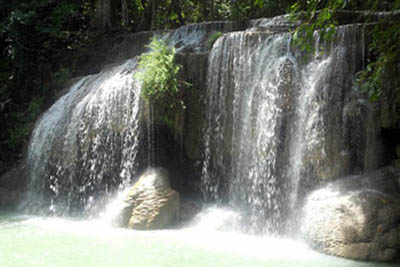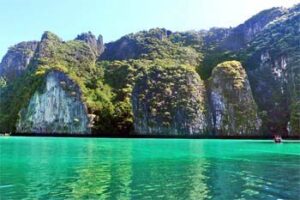
Fishing with the Sea Gypsies: What They Taught Me
By Philipp Meier
I was sitting on the bow of a creaky wooden longtail boat, roughly a mile off Koh Bulon Le’s coast in southern Thailand.
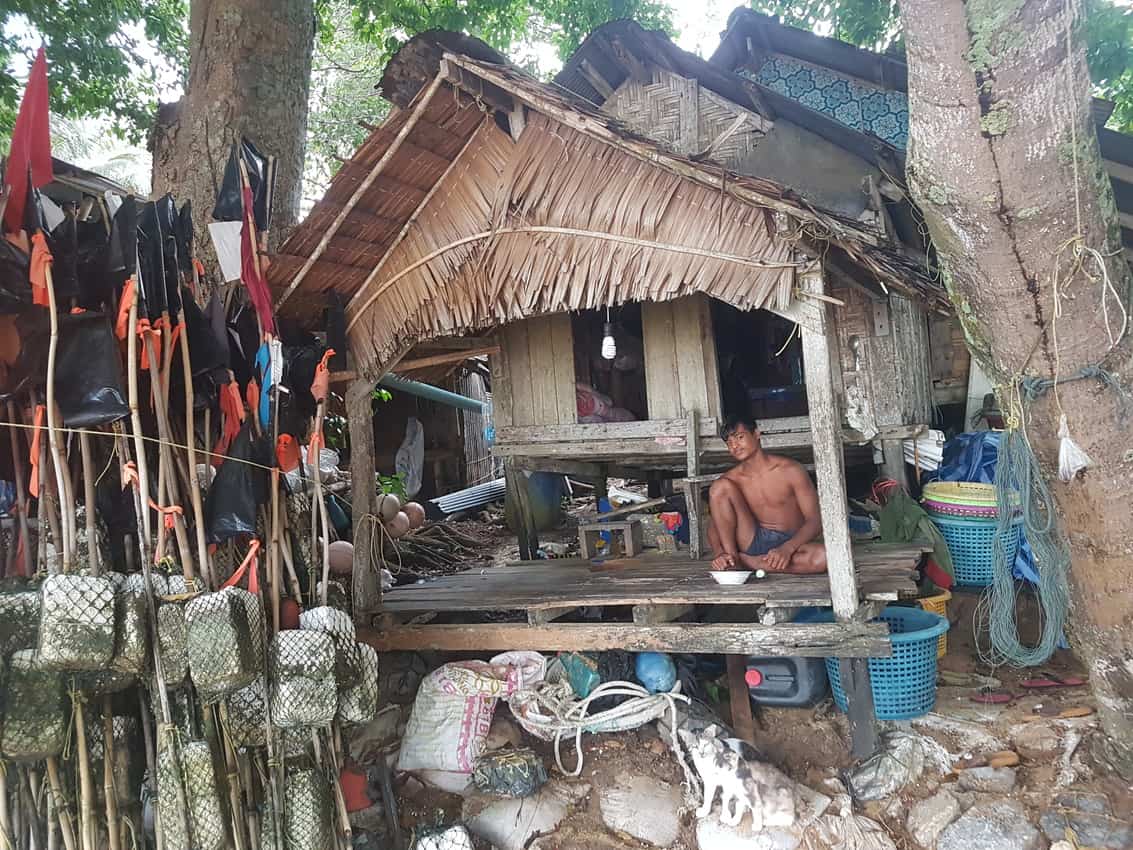
There was a shout, a commotion of splashes and yelps, and with a thud, a grouper landed at my feet. The men cheered and slapped hands, celebrating a significant haul.
These are Thailand’s “sea gypsies” – people who have lived almost entirely on the sea for generations, and I was learning the tricks of fishing these pristine, crystal waters. But I was also learning a lot more…
Settling Down on Land
“There are about 100 sea gypsies on Koh Bulon Le – the only people here,” said Lene, a Danish ex-pat who’d been living on another island near Bulon for many years when I met her in May 2019.
She knew the island of Koh Bulon Le quite well because she’d been here many times.
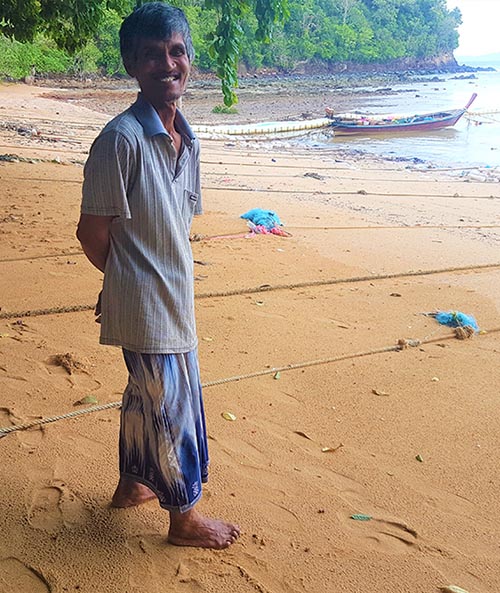
Nomadic Gypsies
Even though the sea gypsies have settled down here, they’re still regarded as nomadic people.
This is because these folks used to swap the sea for the land when the monsoon and changing winds forced them to migrate and look for other food resources.
Thailand’s 4,000 “people of the sea” – the Chao Le – used to live this nomadic lifestyle until the ’90s when developers pushed most sea gypsies onto land, robbing them of the bays they moored in to build villas and seaside resorts.
Besides, due to a clampdown on illegal immigrants, hopping between Myanmar and Thailand no longer made sense. Most sea gypsies didn’t have papers and weren’t Thai citizens, even though they’d been living in Thailand their whole lives.
After the devastating tsunami in 2004, the Thai government tried to solve the problem of statelessness once and for all, but only 200 were given full identification after proving they were born in Thailand. All the others just got residency cards, reads a Guardian article.
One of these Chao Le is Mr. Malek. Meeting him at Koh Bulon Le’s Mango Bay in the south of the tiny island, I learned that he’s been living here for 13 years already.

Getting to Know the Sea Gypsies
“Chob niab, (I like it quiet) that’s why I came here,” Mr. Malek said and laughed heartily. The fact that Mango Bay’s beach is nowhere near as white and powdery as its neighboring School Beach doesn’t bother him in the slightest. What matters most to him and other sea gypsies is that the place is away from the crowds.
Mr. Mad, his friend, has been calling this place home for even 20 years. He told me that he used to live on the mainland in La-ngu, a district in southern Thailand, fairly close to Malaysia.
“What made you decide to move here?” I asked.
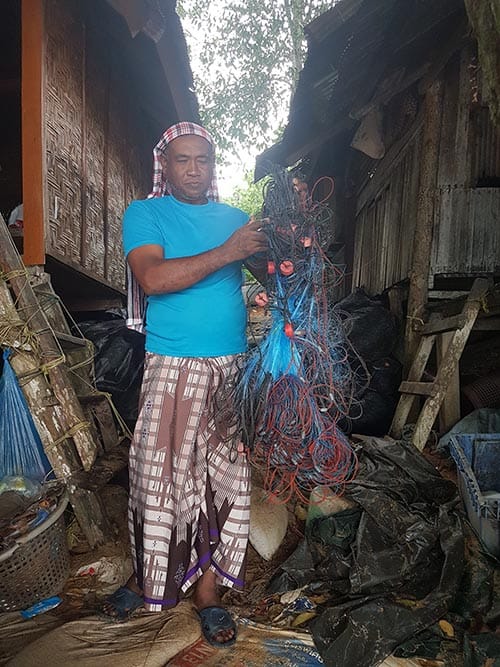
“Here much everything from the sea,” he replied. “Pak Bara not so much.” Pak Bara is a small village in southern Thailand that serves as a transport hub for tourists. “In Pak Bara everything: car, motorbike,” he added.
Then, Mr. Rud chimed in, “mai chop siang dang,” (he doesn’t like noise) and laughed.
All three guys were darkly-tanned and clad in a tee and a piece of fabric wrapped around their waists. With very few modern or sophisticated possessions – Mr. Malek’s cell phone was tiny and ancient, not even good enough for taking pictures – and a pretty tough working life, these guys still radiated joy.
The discovery of very pure happiness in Mr. Malek and his friends, despite living in what many would find to be pretty basic conditions, was inspiring.
Life Hasn’t changed for the Gypsies
They were telling me island life hadn’t changed for decades. People make a living fishing, catching crabs and squid with bamboo traps and nets, and by selling rubber.
“Chop beb nee,” (I like it like this) Mr. Malek said and smiled contentedly, embodying Thailand’s smile culture.
I asked Mr. Malek what he thinks would become of Koh Bulon Le in five to ten years, and he said humbly, “If stay the same, good.”
Going Fishing
With that, I thanked them for the chat, and it was then that Mr. Rud told me that Mr. Malek and a 17-year-old boy were going on a fishing trip the next day and that I could join them if I wanted.
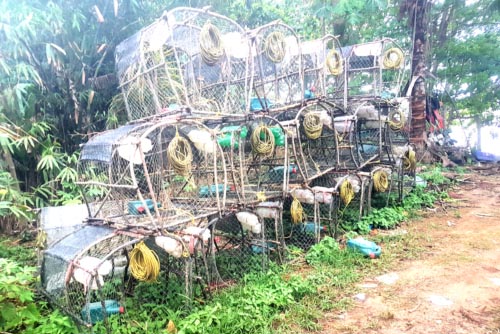
I’m not a morning person, but being invited on a private fishing trip with sea gypsies… I couldn’t decline.
Giddy with excitement, I said, “I’m in. See you tomorrow,” and dashed through the jungle, running away from buzzing sounds of striped-legged mosquitoes eager to take a blood meal.
Setting off for Koh Bulon Le’s Sea
There was a light breeze when I reached Mango Bay at 9 am. Cicadas were screeching in the distance as if rehearsing for a ceremony, and there was something soothing about those chorusing insects.
It matched the scent of salty sea air, the small lapping waves, the gentle rocking of moored longtail boats, and the laid-back sea gypsies dreaming of a good day’s haul.
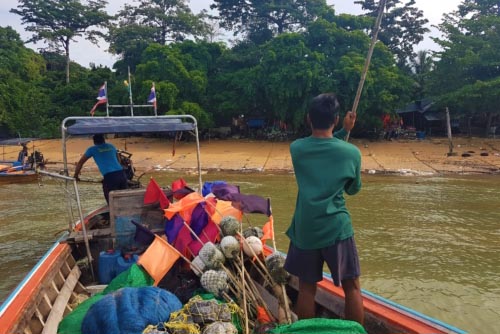
Walking to Mr. Malek and the youngster, I watched the boy carrying some fishing nets and buoys to the longtail boat. The guys were just about ready; I’d arrived in the nick of time.
Wading through the water with my flip flops in hand and my cell phone dangling from my neck, protected in a waterproof zip-lock bag, I jumped into the longtail boat.
It was high tide when the captain fired up the engine, resulting in a puff of smoke blasting out the back of it.
But that’s not to say that the waters were deep. The boy had to use a long bamboo push pole to help Mr. Malek get his rickety boat out of the shallow waters.
Heading out to sea, I enjoyed the chugging sounds of Mr. Malek’s longtail boat and the absence of boisterous tourists. Taking to the waves, I peered at Koh Bulon Le that appeared smaller and smaller. Time and again, the scene was covered by salt sprays from high waves splashing against the vessel as though crashing into rocks – invigorating face washes indeed.
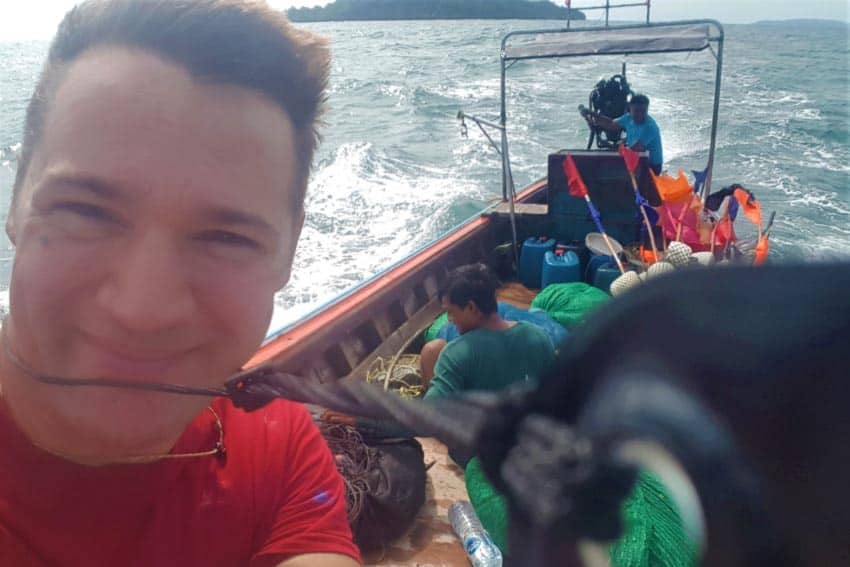
The experience felt like an amusement park ride with the longtail boat rocking side to side, nearly touching the sea’s surface, and bouncing from the top of each five-meter wave.
I loved the tingling feeling in my tummy, that free-fall state of plummeting down, but I did check the sea gypsies’ expressions to gauge whether we were safe. And they were smiling, enjoying the adventurous ride just as much as I did.
Studying Local Fishing Techniques
A few moments later, Mr. Malek piloted in a circle and then stopped.
Turning off the engine, he explained, “Song kilo mai pen rai; boat lek,” (two kilometers are okay; small boat) pointing at a police ship. “Here, about 1.5 kilo.”
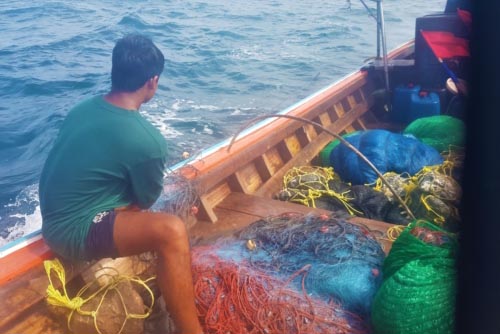
Fishing on longtail boats is only allowed within two kilometers of Koh Bulon Le. Fishermen on big vessels, on the other hand, must keep a distance of at least two kilometers.
A much more effective fishing method than casting a line is the technique they were about to teach me now. Despite catching a grouper – beginner’s luck – I was keen to learn more.
I watched the boy deftly attaching floats and sinkers to the head rope and foot rope. Then, Mr. Malek let down the first net and continued with another one a few hundred meters further away.
Despite my struggle with the language barrier, I now figured out that what I’d taken to be mere buoys to plot the fishing spots were also floats to attach to the head ropes. This part of their routine was drift netting after all – fishing with nets that hang vertically in the water and drift with the current.
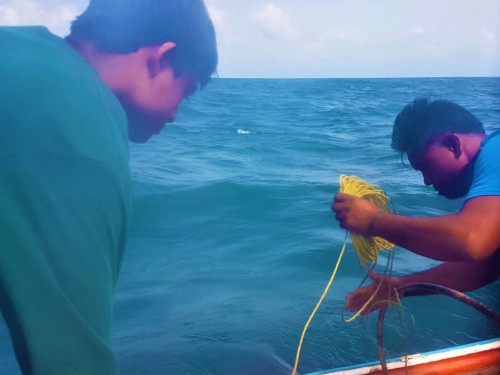
Meanwhile, the teenager got sick; the poor boy wasn’t used to the swell. Even so, he took it in stride, showered himself with a bucket of seawater, and soldiered on.
I found it interesting that a sea gypsy would still get seasick. Apparently, few people are born with sea legs. Mr. Malek laughed vigorously and played it down, “One to two years, then okay.”

Having fished Koh Bulon Le’s waters for more than a decade, he was used to the roller-coaster waves.
“So, you’re saying the secret to overcoming seasickness is perseverance?” I asked.
“Chai,” (Yes) he said in reply and laughed out loud again.
Mr. Malek let down nine gillnets in total and explained that he’d let each of them drift at a depth of ten meters for two days.
He said he’d collect his rap (nets) at 5 am and would be back at Mango Bay at 10 am, but the idea of getting up even before the chickens woke up didn’t appeal to me. He, however, had a child-like sparkle in his eyes.
At 12:30 pm, we were about to head back, and one question was still preying on my mind.
“Is there anything you dream of?” I asked.
“Switzerland. Not far. I can go…. – in the dream,” Mr. Malek bantered and added, “I like it here; I don’t need to travel. But in the high season, farang maaaaak (a lot of foreigners).”

By that, he was exaggerating, because Bulon is still fairly little-known among foreigners and even Thais, but I got the message: he likes blissfully uncrowded places. And he isn’t alone.
Delving into Bulon’s and Sea Gypsies’ Destiny
Sea gypsies love to live away from civilization. Secludedness and natural beauty are essential ingredients for them to feel at ease, and Koh Bulon Le with its unspoiled nature certainly fits the bill. According to Lene the Dane I’d talked to earlier, Thailand’s government had declared Koh Bulon Le a national park, and that means it’s no longer allowed to construct any houses.
She’d also told me that the sea gypsies had been staying at School Beach before Pansand was built, a resort that’s sandwiched between the jungle and a white beach with soft, Tempur-pillow-like sands.

These days, Bulon’s sea gypsies sleep at Mango Bay in huts, close to the jungle, which is a poignant reminder of Christmas 2004. After the tsunami, the Chao Le were no longer allowed to site their bungalows with stilts in the water, a cultural tradition that symbolized life between the sea and land, much like turtles that sea gypsies regard as imaginary relatives.
Material Goods and Money Mean Nothing to Gypsies
Contrary to popular belief, money and material goods have never appealed to these people. I was quite surprised when Mr. Malek, after some four hours out at sea, refused a tip I’d offered. It struck me that he was even offended.
It’s not all about money, I concluded, pleased with the fact that the sea gypsies I’d met were neither greedy nor grasping.
“Do you have a Facebook or Line account?” I asked Mr. Malek, eager to see some photos of his catch.
Showing me his nostalgic, tiny cell phone, he said, “I only have this,” and smiled, indicating that he was happy with what he had. This man who had clearly found peace here was living proof of a fulfilled life in one quiet corner of the world, and I could see why.
Sitting at Pansand’s restaurant, listening to hornbills’ distinctive cries, I thought to myself, Koh Bulon Le provides him with everything he needs: warm people, soul-soothing nature, enough to eat and a roof over his head.
Taking in the warm, salty air, gazing at a deserted beach with turquoise waters and sand as white as coconut meat, I enjoyed the calming sounds of ocean waves washing up against the shore.
Then, pleased with the sea gypsies’ idea of living happily in one place without social media, far away from gilded rooms and greed, I tucked into my trophy – the grouper that landed on my plate.
 Philipp Meier is a travel writer, content creator, and English / German translator with a passion for Thai culture and traveling off the well-trodden tourist trail in the Land of Smiles. His work has been published at BootsnAll, Motorcycle Sport & Leisure Mag, BookaWay, YourLifeIsATrip, and others. You can find him at writerphilippmeier.com
Philipp Meier is a travel writer, content creator, and English / German translator with a passion for Thai culture and traveling off the well-trodden tourist trail in the Land of Smiles. His work has been published at BootsnAll, Motorcycle Sport & Leisure Mag, BookaWay, YourLifeIsATrip, and others. You can find him at writerphilippmeier.com
- Missouri Sports Travel Adventure: From Landmarks to Ballparks - January 21, 2026
- What First-Time Visitors Get Wrong About Visiting Iceland - January 15, 2026
- Bareboat Charter vs all-inclusive Crewed: Which Luxury Charter Fits You? - December 29, 2025





